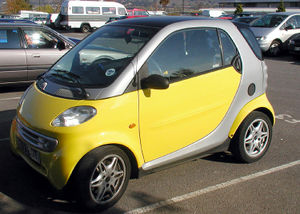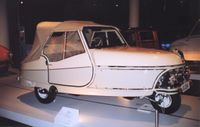Microcars
Car Show
Microcars
 This
Smart car is an example of a microcar
This
Smart car is an example of a microcarA microcar is an extremely
small
automobile. Various definitions are used, including "less than 3
metres in length" and "less than 85 cubic feet/2400 litres interior volume".
Typically, microcars seat only the driver and a single passenger, and many have
only three wheels. Microcars are usually designed and produced for economic
purposes when materials and heavy equipment are scarce or fuel is scarce and
expensive. Many microcar designs flourished in post-World War II Europe,
particularly in Germany, where former military aircraft manufacturers such as
Messerschmitt and Heinkel were prominent microcar makers. The Messerschmitt
KR175, KR200 and TG500 even had aircraft-style bubble canopies, giving rise to the term
bubble car to refer to all these post-war microcars. Isettas and
others also had bubble-like appearance.
France also
produced large numbers of similar tiny vehicles called
voiturettes,
but unlike the German makes, these were rarely sold abroad. Very small cars have
also been popular in
Japan, where again they attract various tax and insurance benefits when
compared to other vehicles. These are known as
keicars and
differ from most of the European microcars in that they are typically designed
and built as scaled-down versions of very traditional car configurations, while
European microcar designs tend to be unorthodox and sometimes bizarre.
The
Smart or "smart" (now called Fortwo) launched in
1998 could be seen as a successful re-invention of the microcar principle. Like
the Japanese keicars, it is of relatively conventional design. Microcars built
in Europe after World War I were often motorcycle based and referred to as "cycle cars".
Another name for microcar is Station Car, where the intended use is to
travel from a suburban home to an interurban transit station or
Park and Ride lot where the vehicle remains until the operator returns from the
commute to and from the workplace. In some locations electric vehicle recharging
is provided to encourage the use of electric vehicles. NEVs may also be used as station cars where the roadway speed limits permit
such use.
Reasons for microcars
The economy of operating such a small car (mostly in fuel and tires) has
often been helped by three-wheeled microcars or cars with very small engines
being treated as motorcycles for tax and insurance purposes. In some countries
(e.g. Austria) three-wheelers with a certain maximum weight were considered as
motorcycles with side car and therefore no car drivers license was needed. This
was assuring a certain market for elder people who did not want to pass a car
drivers license. Three wheelers are a separate class of their own in Britain. In
Germany, what could be driven with a motorcycle license depended only on engine
displacement, so many of the microcars had four wheels. The Corbin Sparrow is licensed as a motorcycle and parked in motorcycle spaces
in California, and probably in other places.
In some European countries, taxes used to depend on engine displacement
and/or insurance on power. This has given rise to names of such cars as
Citroën 2CV and Renault 4CV. This favorable treatment by governments is based on
the benefits to a society of reducing use of such resources as minerals, parking
space and foreign exchange, reduced noise and chemical pollution, reduced hazard
to others and etc. Reduced global warming from carbon dioxide emission has now been added to this list.
Although microcars use much less fuel than the more common sizes do, they are
still far from record and competition fuel economy, which is measured in
thousands of miles per gallon (or in ml./100 km.).
Another advantage is the ease of parking. Some microcars can be parked
perpendicular, where other cars park parallel, or be lifted by hand, like a motor
scooter, to get into a tight spot. The Isetta and some others had forward
entry, to facilitate perpendicular parking close to other vehicles.
The small size improves
handling by reducing the angular inertia. The Messerschmitt and Spatz have been
described as much better than ordinary cars on snow and ice. Spare room on the
road and ease of missing obstacles are also improved. For the performance
oriented, who prefer more than two wheels or a roof, the scaling laws show that
one need not give up acceleration until the curb weight comes down to around the
driver's weight, because power per weight of the car itself improves with small
size, in an otherwise similar design. Top speed is lost with small scale, due to
the decreased Reynolds number, but this is a small effect. The Messerschmitt TG500 had
about a 90 mph (125 km/h) top speed with 20 horsepower (15 kW) and intuitive
aerodynamics.
Microcars by countries
Austria
Felber Autoroller
Möve
Libelle
Brazil
Dacon
Obvio!
Romi Isetta
France
Aixam
Ardex
Bugatti supercharged 375 cc (half the size of a Bébé). Canceled when Ettore
Bugatti died.
Early small engined Citroën 2CVs, in spite of passenger space and comfort.
Citroën Prototype C
Ligier BeUp
Microcar
Mochet 100 (1948) This was a revival of the 1924 Mochet cycle car or vélocar
Smart
Valle Chantecler, 1956, 125 cc.
VELAM Isetta, 1954-1958
Vespa designed in Italy, made in France 1957-1961
Willam
Germany
BMW Isetta
Brütsch Mopetta
Fend Flitzer
Fuldamobil N2, (1952–1955)Also made under licence in Chile (as the Bambi),
Netherlands (as the Bambino), South Africa, Sweden (as the Fram King Fulda),
Greece (as the Attica and also the Alta , India (as the Hans Vahaar) and
United Kingdom (as the Nobel).
Glas Goggomobil
Goliath Pioneer (1934, three wheels)
Heinkel Kabine See also Trojan (UK)
Kleinschnittger (notably the Kleinschnittger F125 roadster)
Some Lloyds, made by Borgward, the Lloyd LP300s, of 1950, may have been
small enough to be micros
Messerschmitt KR175
Messerschmitt KR200
Messerschmitt TG500 (Four wheeler)
Meyra 55, (1950)
Opelit Mopetta
Spatz
Trabant
Zündapp Janus
Greece
Alta
Attica
B.E.T.
Hungary
Balaton
Puli
Italy
Autobianchi Bianchina (Fiat 500 based)
Fiat Topolino
Fiat 500
Fiat 500 Zagato (1970)
Fiat Abarth Zagato, 750 cc, exotic sports car
Iso Isetta, 1953-1955
Lawil
Vespa 400
Zagato Zele 1000 (1976)
India
REVA
Japan
Fuji Cabin
Honda Canopy
Honda S600 sports car
Honda N360 K car
Mitsuoka K-1
Subaru 360 (This was imported to the US in considerable numbers.)
Poland
Mikrus MR-300
Portugal
- The Sado 550 was a Portuguese microcar. Around 500 were produced
from 1982 to 1984. Only a few dozen still circulate today.
Spain
 David Torpedo 2 S
David Torpedo 2 S
Biscúter
David
Kapi
United Kingdom
AC Clipper
Austin Seven (1922. Early post-war A30s and some early Minis were also
called "Austin Seven".)
Berkeley Caravan manufacturers. Design by Laurie Bond.
Bond Bug 700cc four cylinder engine. Made by Reliant, Tamworth,
Staffordshire.
Bond Minicar Villiers two-stroke engines. 1949-1965 Made by Sharps
Comercials of Preston. Designed by Laurie Bond.
Cleco 1936-1940 Electric microcar. Also vans.
Frisky Wolverhampton.
Isetta Assembled in Brighton under license from BMW.
The high performance Morgan three wheeler, Triking Cyclecar and perhaps
Lotus Seven should be mentioned, in spite of their larger engines.
Opperman 1956-1959
Peel
Peel P50 (Made on the Isle of Man)
Peel Trident (Made by the same company as the Peel P50)
Power-Drive
Raleigh 1933-1936
Reliant Robin
Rodley 1954-1955
Russon 1951-1952
Rytecraft 1934-1940 Originally 98 cc later 250 cc. One was actually driven
round the world in 1960.
Scootacar 1957-1965 Made by Hunslet in Leeds
Tourette 1956-1957
Trojan (Licence built version of the Heinkel)
Unique Motor Company QPod
United States
American Bantam
Commuter Cars Tango
Corbin Sparrow
Crosley, various models
King Midget, three models
USSR
ZAZ-965
Electric microcars
Some examples of battery electric microcars are:
- The Th!nk City, imported to the USA by Ford Motor Company to satisfy
California Zero-emissions vehicle (ZEV) requirements in the state of
California. Removed from the market by Ford in a bargain with the California
Air Resources Board. See PZEV for more information.
- The REVA electric vehicle as used in its home environment, India. This
may soon be exported to the USA with speed electronically limited and sold
as an NEV.
- The obstacle to adaptation of such vehicles in the United States is less
technical than cultural and political. The mandates by regulatory powers
that such vehicles to meet full U.S. safety regulations ensures the
unavailability of vehicles suitable for use in mixed traffic conditions that
predominate in U.S. suburban areas. To supporters of electric vehicles this
appears not to be an accident.
See also
External links
References
- Bugatti, The Man and the Marque - by Jonathan Wood, 1992
- Kleinwagen, Small Cars, Petites Voitures - by Hans-Ulrich von
Mende and Matthias Dietz, Benedikt Taschen, 1994
Home | Up | List of cars | Vehicle size class | Microcars | Hatchback | Sedan | Station wagon | Sportive cars | Cabriolet | Convertible | Four-wheel drive | Minivan | Brass Era car | Personal luxury car | Recreational vehicle | Vintage car | Full-size vehicles | Keicars | Hybrid vehicles | Luxury vehicles | Mid-size car | Pickup trucks | Prestige vehicles | Production Electric vehicles | 2 plus 2 | Air car | Compact SUV | Concept cars | Cyclecar | Leisure activity vehicle | Limousine | Personal luxury car | Pony car | Professional car | Safety car | Show car | Sport compact | Voiturette | Green vehicles | Off-road vehicles | Steam automobiles
Car Show, made by MultiMedia | Free content and software
This guide is licensed under the GNU
Free Documentation License. It uses material from the Wikipedia.
|







